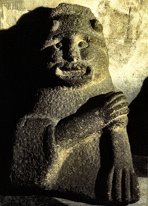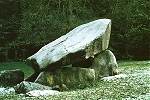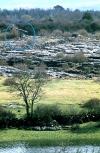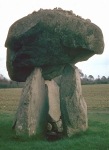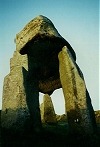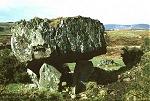|
portal-tombs
the
earth-mother's
HOW TO IDENTIFY PORTAL-TOMBS
Portal-tombs are easily identified by their compactness: unlike other kinds of tomb, they tend to be much higher than they are long or wide. Their chief characteristics are the portal-stones forming the entrance, and the capstone(s) which are always impressive. When both these features are missing, the remains are hardly worth identifying, except by professional archæologists. Sometimes their long cairns still survive, and these tend to be longer than those of wedge-tombs and shorter than those of court-tombs. The portal-tomb was built at one end of the cairn, facing outwards - which can be any point of the compass. In some cases there were two tombs in the same cairn (as at Ballyrenan, county Tyrone), one at each end.
|
|
They are,
moreover, wonderfully sculptural, and fine subjects for photography,
whereas court-tombs are very difficult to photograph except in
detail. The most striking feature of portal-tombs is the massive capstone of the single chamber, supported on two portal-stones, between which a door-stone often survives. Occasionally, a free-standing pillar-stone beside the portal-stones suggests a harking back to a forecourt-tradition - for these sepulchres, built at the end of long cairns, are a kind of extremely refined and compact court-tomb. One or both surfaces of the capstones are almost always tilted at an angle not too far from 30 degrees, whose serious significance is lost in the fog of time. Chocking-stones were often inserted to ensure not just stability but the correct angle, indicating a construction perhaps more precise than might be supposed. A good example is at Kilclooney More in Donegal - but the most startling use of chockers that I have encountered is in the Dordogne. The large capstones (up to 100 tonnes in weight) were most likely raised by a simple and effective system of logs used as rollers, strong wooden poles used as levers (which also acted as brakes) and a ramp.
In some tombs the capstones are double, a larger one partly supported by a smaller to the rear of the tomb. The most appealing and remarkable feature of portal-dolmens compared with other megaliths is the alteration in appearance according to the angle of view. In this they are truly sculptural. Whereas
court-tombs are concentrated in the North and West of Ireland,
especially on upland at around 200 metres, portal-tombs also occur
in the East, South and South-West of the island, sometimes on
quite low ground near the coasts - as with court-tombs. Most are
tucked away in less open places than the court-tombs,
are hidden
away in hollows. But most, like Legananny in county Down, the little dolmen at Altdrumman in county Tyrone, and the spectacular ruin at Muntermellan in Donegal, command impressive vistas. The tomb at Legananny in county Down is oriented so that the underside of the dramatic roofstone and the tip of the backstone are lit by the early-morning sun around the winter solstice - a feature well-known in certain famous passage-tombs, but not generally associated with portal-tombs, which can, more than any other type of megalith, triumph over present-day indignity, and some
may house the living in the future, as they did in the past. |
>> More Portal-tombs >>
or proceed:
For maps of tombs and stone circles in Ulster (six counties) peatlands see:
www.peatlandsni.gov.uk/archaeology/tombs.htm#stonecirclesmap
Click on the
thumbnails
to see large
high-
resolution
pictures.

